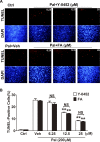Therapeutic Effects of a Novel Agonist of Peroxisome Proliferator-Activated Receptor Alpha for the Treatment of Diabetic Retinopathy
- PMID: 28979999
- PMCID: PMC5633008
- DOI: 10.1167/iovs.16-21402
Therapeutic Effects of a Novel Agonist of Peroxisome Proliferator-Activated Receptor Alpha for the Treatment of Diabetic Retinopathy
Abstract
Purpose: Clinical studies have shown that peroxisome proliferator-activated receptor alpha (PPARα) agonist fenofibrate has therapeutic effects on diabetic retinopathy (DR). The purpose of this study was to identify a novel PPARα agonist and to evaluate its beneficial effects on DR.
Methods: The transcriptional activity of PPARα was measured by a luciferase-based promoter assay. TUNEL was used to evaluate apoptosis in retinal precursor cells (R28). Diabetes was induced in rats by injection of streptozotocin. Retinal inflammation was examined using leukostasis assay, and retinal vascular leakage was measured using permeability assay. Retinal function was measured using electroretinogram (ERG) recording, and retinal apoptosis was quantified using the cell death ELISA. The anti-angiogenic effect was evaluated in the oxygen-induced retinopathy (OIR) model.
Results: A compound, 7-chloro-8-methyl-2-phenylquinoline-4-carboxylic acid (Y-0452), with a chemical structure distinct from existing PPARα agonists, activated PPARα transcriptional activity and upregulated PPARα expression. Y-0452 significantly inhibited human retinal capillary endothelial cell migration and tube formation. The compound also protected R28 cells against apoptosis and inhibited NF-κB signaling in R28 cells exposed to palmitate. In diabetic rats, Y-0452 ameliorated leukostasis and vascular leakage in the retina. In addition, Y-0452 preserved the retinal function and reduced retinal cell death in diabetic rats. Y-0452 also alleviated retinal neovascularization in the OIR model.
Conclusions: Y-0452 is a novel PPARα agonist and has therapeutic potential for DR.
Figures









Similar articles
-
Therapeutic effects of PPARα agonists on diabetic retinopathy in type 1 diabetes models.Diabetes. 2013 Jan;62(1):261-72. doi: 10.2337/db11-0413. Epub 2012 Oct 5. Diabetes. 2013. PMID: 23043158 Free PMC article.
-
Effects of peroxisome proliferator-activated receptor gamma and its ligand on blood-retinal barrier in a streptozotocin-induced diabetic model.Invest Ophthalmol Vis Sci. 2006 Oct;47(10):4547-52. doi: 10.1167/iovs.05-1432. Invest Ophthalmol Vis Sci. 2006. PMID: 17003451
-
Effect of dual PPAR-α/γ agonist saroglitazar on diabetic retinopathy and oxygen-induced retinopathy.Eur J Pharmacol. 2021 May 15;899:174032. doi: 10.1016/j.ejphar.2021.174032. Epub 2021 Mar 19. Eur J Pharmacol. 2021. PMID: 33753107
-
Pathogenetic potential of leukocytes in diabetic retinopathy.Semin Ophthalmol. 1999 Dec;14(4):233-9. doi: 10.3109/08820539909069542. Semin Ophthalmol. 1999. PMID: 10758224 Review.
-
[PPAR gamma: a novel pharmacological target against retinal and choroidal neovascularization].J Fr Ophtalmol. 2005 Mar;28(3):326-30. doi: 10.1016/s0181-5512(05)81062-9. J Fr Ophtalmol. 2005. PMID: 15883500 Review. French.
Cited by
-
The involvement of the mGluR5-mediated JNK signaling pathway in rats with diabetic retinopathy.Int Ophthalmol. 2019 Oct;39(10):2223-2235. doi: 10.1007/s10792-018-01061-w. Epub 2019 Jan 3. Int Ophthalmol. 2019. PMID: 30607864
-
Future Directions in Diabetic Retinopathy Treatment: Stem Cell Therapy, Nanotechnology, and PPARα Modulation.J Clin Med. 2025 Jan 21;14(3):683. doi: 10.3390/jcm14030683. J Clin Med. 2025. PMID: 39941353 Free PMC article. Review.
-
Emerging Roles of Dyslipidemia and Hyperglycemia in Diabetic Retinopathy: Molecular Mechanisms and Clinical Perspectives.Front Endocrinol (Lausanne). 2021 Mar 22;12:620045. doi: 10.3389/fendo.2021.620045. eCollection 2021. Front Endocrinol (Lausanne). 2021. PMID: 33828528 Free PMC article. Review.
-
Molecular mechanisms of retinal ischemia.Curr Opin Physiol. 2019 Feb;7:41-48. doi: 10.1016/j.cophys.2018.12.008. Epub 2018 Dec 28. Curr Opin Physiol. 2019. PMID: 34322649 Free PMC article.
-
Regulation of Monocyte Activation by PPARα Through Interaction With the cGAS-STING Pathway.Diabetes. 2023 Jul 1;72(7):958-972. doi: 10.2337/db22-0654. Diabetes. 2023. PMID: 37058417 Free PMC article.
References
-
- Fong DS, Sharza M, Chen W, Paschal JF, Ariyasu RG, Lee PP. . Vision loss among diabetics in a group model Health Maintenance Organization (HMO). Am J Ophthalmol. 2002; 133: 236– 241. - PubMed
-
- Xie TY, Yan W, Lou J, Chen XY. . Effect of ozone on vascular endothelial growth factor (VEGF) and related inflammatory cytokines in rats with diabetic retinopathy. Genet Mol Res. 2016; 15: 1– 11. - PubMed
-
- Gao X, Li Y, Wang H, Li C, Ding J. . Inhibition of HIF-1alpha decreases expression of pro-inflammatory IL-6 and TNF-alpha in diabetic retinopathy [published online ahead of print June 11, 2016]. Acta Ophthalmol. doi:10.1111/aos.13096. - DOI - PubMed
Publication types
MeSH terms
Substances
Grants and funding
LinkOut - more resources
Full Text Sources
Other Literature Sources
Medical
Molecular Biology Databases

